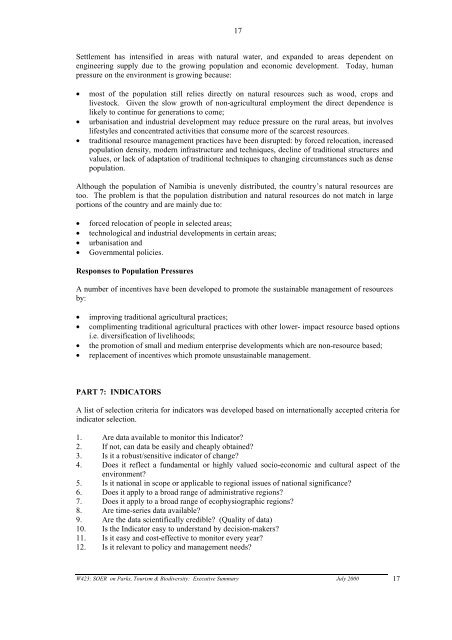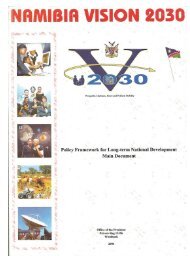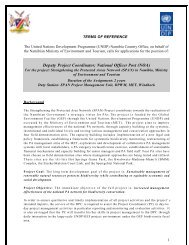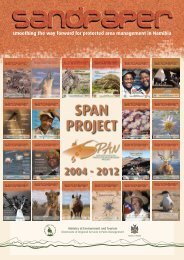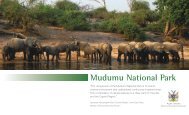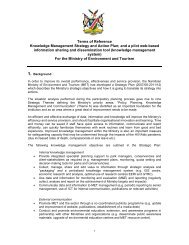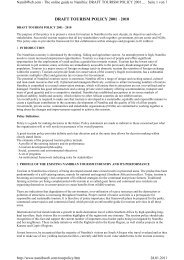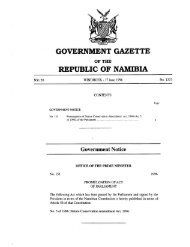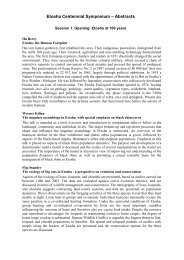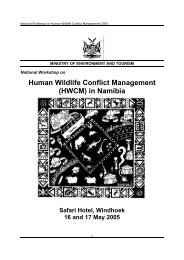EXECUTIVE SUMMARY - Ministry of Environment and Tourism
EXECUTIVE SUMMARY - Ministry of Environment and Tourism
EXECUTIVE SUMMARY - Ministry of Environment and Tourism
You also want an ePaper? Increase the reach of your titles
YUMPU automatically turns print PDFs into web optimized ePapers that Google loves.
17<br />
Settlement has intensified in areas with natural water, <strong>and</strong> exp<strong>and</strong>ed to areas dependent on<br />
engineering supply due to the growing population <strong>and</strong> economic development. Today, human<br />
pressure on the environment is growing because:<br />
• most <strong>of</strong> the population still relies directly on natural resources such as wood, crops <strong>and</strong><br />
livestock. Given the slow growth <strong>of</strong> non-agricultural employment the direct dependence is<br />
likely to continue for generations to come;<br />
• urbanisation <strong>and</strong> industrial development may reduce pressure on the rural areas, but involves<br />
lifestyles <strong>and</strong> concentrated activities that consume more <strong>of</strong> the scarcest resources.<br />
• traditional resource management practices have been disrupted: by forced relocation, increased<br />
population density, modern infrastructure <strong>and</strong> techniques, decline <strong>of</strong> traditional structures <strong>and</strong><br />
values, or lack <strong>of</strong> adaptation <strong>of</strong> traditional techniques to changing circumstances such as dense<br />
population.<br />
Although the population <strong>of</strong> Namibia is unevenly distributed, the country’s natural resources are<br />
too. The problem is that the population distribution <strong>and</strong> natural resources do not match in large<br />
portions <strong>of</strong> the country <strong>and</strong> are mainly due to:<br />
• forced relocation <strong>of</strong> people in selected areas;<br />
• technological <strong>and</strong> industrial developments in certain areas;<br />
• urbanisation <strong>and</strong><br />
• Governmental policies.<br />
Responses to Population Pressures<br />
A number <strong>of</strong> incentives have been developed to promote the sustainable management <strong>of</strong> resources<br />
by:<br />
• improving traditional agricultural practices;<br />
• complimenting traditional agricultural practices with other lower- impact resource based options<br />
i.e. diversification <strong>of</strong> livelihoods;<br />
• the promotion <strong>of</strong> small <strong>and</strong> medium enterprise developments which are non-resource based;<br />
• replacement <strong>of</strong> incentives which promote unsustainable management.<br />
PART 7: INDICATORS<br />
A list <strong>of</strong> selection criteria for indicators was developed based on internationally accepted criteria for<br />
indicator selection.<br />
1. Are data available to monitor this Indicator<br />
2. If not, can data be easily <strong>and</strong> cheaply obtained<br />
3. Is it a robust/sensitive indicator <strong>of</strong> change<br />
4. Does it reflect a fundamental or highly valued socio-economic <strong>and</strong> cultural aspect <strong>of</strong> the<br />
environment<br />
5. Is it national in scope or applicable to regional issues <strong>of</strong> national significance<br />
6. Does it apply to a broad range <strong>of</strong> administrative regions<br />
7. Does it apply to a broad range <strong>of</strong> ecophysiographic regions<br />
8. Are time-series data available<br />
9. Are the data scientifically credible (Quality <strong>of</strong> data)<br />
10. Is the Indicator easy to underst<strong>and</strong> by decision-makers<br />
11. Is it easy <strong>and</strong> cost-effective to monitor every year<br />
12. Is it relevant to policy <strong>and</strong> management needs<br />
W423: SOER on Parks, <strong>Tourism</strong> & Biodiversity: Executive Summary July 2000 17


